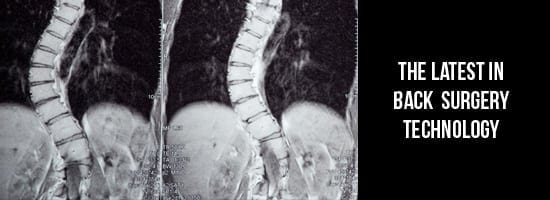
Back surgery is generally less invasive than it was even a decade ago. Many common procedures can now be performed with smaller incisions and increased dexterity on the part of the surgeon with the assistance of tiny cameras. The purpose of most advances in back surgery technology is to increase range of motion, reduce recovery time, and minimize the risk of complications.
Artificial Disc Replacement
Approved by the U.S. FDA for use in neck and spine procedures, artificial disc replacement is becoming an increasingly common alternative to traditional fusion surgery. What’s new is the increased selection of artificial discs that may be used to replace a damaged vertebral disc. The goal of the procedure is maintaining range of motion by restoring spinal stability without the need for a fusion.
Vertebral Augmentation
Fractures involving any of the 33 bones of the spine can be difficult to treat. There are two newer surgical techniques available to repair the damage without having to rely solely on nonsurgical treatments that may not effectively relieve related pain.
• Vertebroplasty: A vertebroplasty is an outpatient procedure involving the use of a special cement that’s injected into the cracked or broken vertebra.
• Kyphoplasty: During a kyphoplasty, a balloon is inserted into the affected area and carefully inflated to re-position the fractured bones. The balloon is then removed and cement is used to repair the damage.
Minimally Invasive Fusion Surgery
Less invasive procedures are being applied to all aspects of back surgery, including traditional fusion surgery. Such operations can sometimes be completed with the use of X-ray imaging during surgery (advanced fluoroscopy), improved optics with smaller, more precise tools, and better fixation of screws that need to be affixed to hard-to-reach locations.
Minimally Invasive SI Joint Fusion
Another advancement in minimally invasive techniques applies to sacroiliac (SI) joint fusion surgery. Thanks to advances in technology, SI joint fusion is becoming an increasingly common option to correct an SI joint dysfunction by increasing stability and reducing related nerve pain.
Stem Cell Technology
Several studies are underway to determine how adult stem cells may be used to encourage the regeneration of damaged muscle and bone tissue. It’s hoped that practical applications of stem cell technology may eventually help patients avoid back surgery altogether and promote better healing following surgery for spinal cord injuries.
It’s easy to become overwhelmed when trying to sort through your options for back surgery. Just because a new procedure is available doesn’t mean it’s right for your situation. Make an informed decision by asking questions and clearly understanding what particular surgical options are available to you.

